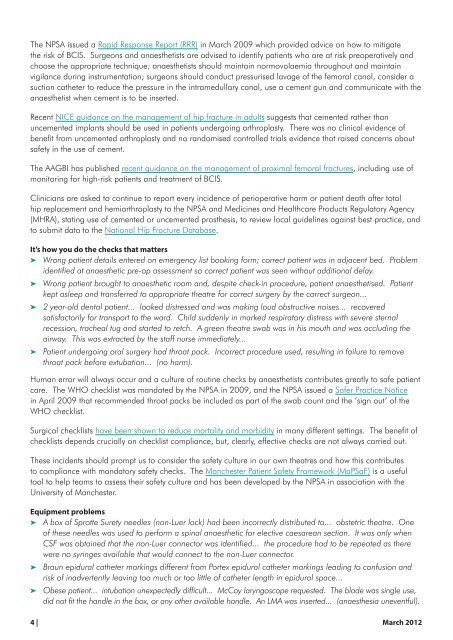PATIENT SAFETY UPDATE - aagbi
PATIENT SAFETY UPDATE - aagbi
PATIENT SAFETY UPDATE - aagbi
You also want an ePaper? Increase the reach of your titles
YUMPU automatically turns print PDFs into web optimized ePapers that Google loves.
The NPSA issued a Rapid Response Report (RRR) in March 2009 which provided advice on how to mitigatethe risk of BCIS. Surgeons and anaesthetists are advised to identify patients who are at risk preoperatively andchoose the appropriate technique; anaesthetists should maintain normovolaemia throughout and maintainvigilance during instrumentation; surgeons should conduct pressurised lavage of the femoral canal, consider asuction catheter to reduce the pressure in the intramedullary canal, use a cement gun and communicate with theanaesthetist when cement is to be inserted.Recent NICE guidance on the management of hip fracture in adults suggests that cemented rather thanuncemented implants should be used in patients undergoing arthroplasty. There was no clinical evidence ofbenefit from uncemented arthroplasty and no randomised controlled trials evidence that raised concerns aboutsafety in the use of cement.The AAGBI has published recent guidance on the management of proximal femoral fractures, including use ofmonitoring for high-risk patients and treatment of BCIS.Clinicians are asked to continue to report every incidence of perioperative harm or patient death after totalhip replacement and hemiarthroplasty to the NPSA and Medicines and Healthcare Products Regulatory Agency(MHRA), stating use of cemented or uncemented prosthesis, to review local guidelines against best practice, andto submit data to the National Hip Fracture Database.It’s how you do the checks that matters➤➤Wrong patient details entered on emergency list booking form; correct patient was in adjacent bed. Problemidentified at anaesthetic pre-op assessment so correct patient was seen without additional delay.➤➤➤➤➤➤Wrong patient brought to anaesthetic room and, despite check-in procedure, patient anaesthetised. Patientkept asleep and transferred to appropriate theatre for correct surgery by the correct surgeon...2 year-old dental patient... looked distressed and was making loud obstructive noises... recoveredsatisfactorily for transport to the ward. Child suddenly in marked respiratory distress with severe sternalrecession, tracheal tug and started to retch. A green theatre swab was in his mouth and was occluding theairway. This was extracted by the staff nurse immediately...Patient undergoing oral surgery had throat pack. Incorrect procedure used, resulting in failure to removethroat pack before extubation... (no harm).Human error will always occur and a culture of routine checks by anaesthetists contributes greatly to safe patientcare. The WHO checklist was mandated by the NPSA in 2009, and the NPSA issued a Safer Practice Noticein April 2009 that recommended throat packs be included as part of the swab count and the ‘sign out’ of theWHO checklist.Surgical checklists have been shown to reduce mortality and morbidity in many different settings. The benefit ofchecklists depends crucially on checklist compliance, but, clearly, effective checks are not always carried out.These incidents should prompt us to consider the safety culture in our own theatres and how this contributesto compliance with mandatory safety checks. The Manchester Patient Safety Framework (MaPSaF) is a usefultool to help teams to assess their safety culture and has been developed by the NPSA in association with theUniversity of Manchester.Equipment problems➤➤A box of Sprotte Surety needles (non-Luer lock) had been incorrectly distributed to... obstetric theatre. Oneof these needles was used to perform a spinal anaesthetic for elective caesarean section. It was only whenCSF was obtained that the non-Luer connector was identified... the procedure had to be repeated as therewere no syringes available that would connect to the non-Luer connector.➤➤➤➤Braun epidural catheter markings different from Portex epidural catheter markings leading to confusion andrisk of inadvertently leaving too much or too little of catheter length in epidural space...Obese patient... intubation unexpectedly difficult... McCoy laryngoscope requested. The blade was single use,did not fit the handle in the box, or any other available handle. An LMA was inserted... (anaesthesia uneventful).4 | March 2012
















